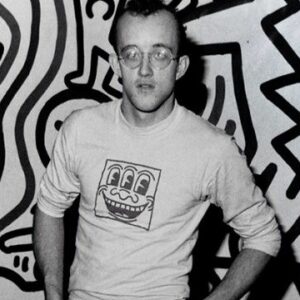Keith Haring was a social activist and artist from the United States. He was instrumental in popularizing graffiti art. He learned the fundamentals of drawing from his father, a cartoonist. At the Pittsburgh Art and Craft Center, he had his first solo exhibition. He experimented with various forms of video and performance art while attending the School of Visual Arts in New York. He also studied the relationship between images in order to hone his drawing ability. In New York, he became acquainted with graffiti art, a relatively new form of expression. He gained recognition for his underground art works over time. He compiled his graffiti works into a book titled “Art in Transit: Subway Drawings.” His graffitis depicted everyday objects such as pyramids, human figures, television sets, animals, and infants. He incorporated graffiti into his various acts of social activism. His artistic endeavors aided in the promotion of literacy. His anti-drug mural is titled Crack Is Wack. He was invited to exhibit his work by the Bordeaux Contemporary Art Museum in France and the Stedelijk Museum in the Netherlands. As an AIDS victim, he spent his later years raising awareness about the disease.
Childhood & Adolescence
Keith Haring was born in Reading, Pennsylvania, to cartoonist father Allen Haring and mother Joan Haring. Additionally, he had three sisters. He has had a passion for art since he was a child.
He used to spend time drawing with his father as a child. In 1976, he graduated from Kutztown Area Senior High School. He studied commercial art at The Ivy School of Professional Art in Pittsburgh from 1976 to 1978.
He organized a solo exhibition of his work at the Pittsburgh Arts and Crafts Center during this time period. After two semesters, he switched to Fine Arts when he lost interest in commercial art.
He enrolled at the School of Visual Art in 1978 upon his arrival in New York City to study semiotics. He became acquainted with a new alternative art community in New York.
This art community introduced him to graffiti, a new form of art that thrived on downtown streets and in public spaces such as subways. He made friends with a number of artists, musicians, and graffiti writers during this time period.
Impressed by the community’s creativity, he began participating in various art exhibitions. He experimented with video, installation, and collage to hone his drawing skills while attending the School of Visual Art.
Career of Keith
He began drawing with white chalk on matte black paper that he discovered over unused advertising panels in a subway station in 1980. Between 1980 and 1985, he created numerous works of art in various subway stations.
Through the use of simple lines, his graffiti reflected his creativity and ideas. He used to create forty subway drawings per day at times. His graffiti work gradually gained popularity among New York City commuters.
In 1981, he organized his first solo exhibition at the Westbeth Painters Space in New York. He exhibited his work at the Tony Shafrazi Gallery the following year.
He also participated in a number of international survey exhibitions, including the Sao Paolo Biennial, the Whitney Biennial, and Kassel’s Documenta 7. He was then working on an animation project for Spectacolor’s Times Square billboard.
He even created the sets and backdrops for a number of theatres and nightclubs. Among his notable brand collaborations, he designed watches for Swatch. Absolut vodka, for example, used his artwork in its advertising campaign.
Between 1982 and 1989, as part of his social service, he created over 50 public artworks for charities, hospitals, and orphanages. In 1986, his sculpture Blue Curling Dog was temporarily displayed in Manhattan’s Dag Hammarsjold Plaza.
In April 1986, he opened the Pop Shop, a retail space in Soho. This shop sells items such as toys, posters, and T-shirts that he has designed. The interior of this shop was designed by him using his white mural creations.
The purpose of this shop was to bring his art to the general public and to sell products designed by him at a reasonable price. He came under fire from several prominent members of the art world for marketing his own works.
He created a mural to commemorate the Statue of Liberty’s centennial. The exterior of the Necker Children’s
Hospital in Paris features a mural. In 1987, he created this mural. In 1987, he painted a large mural on the outdoor pool of the Carmine Recreation Centre in Lower Manhattan.
Apart from his involvement with various art projects, he organized several drawing workshops for children in schools and museums throughout New York and Europe.
He founded the Keith Haring Foundation in 1989. It is the sole owner of Haring’s intellectual property rights. Apart from that, this organization assists AIDS organizations and children’s programs with financial support.
Significant Works Keith
He created the mural Crack Is Wack in 1986. He hoped to raise awareness among youth about the dangers of Crack, a type of cocaine, through the mural’s kinetic figures and abstract forms.
Personal History and Legacies
He was homosexual. He was diagnosed with AIDS in 1988. In later years of his life, he was an outspoken advocate for raising awareness about deadly diseases such as AIDS.
At the age of 31, he died of AIDS-related complications. Over 1000 people attended his funeral service, which was held at New York’s Cathedral of St. John the Divine.
Estimated Net Worth
Keith Haring is one of the wealthiest and most popular Pop Artists. Keith Haring’s net worth is estimated to be around $40 million, based on our analysis of Wikipedia, Forbes, and Business Insider.
Trivia
In one of his interviews, this gifted American artist admitted that he desired to become a hippie while in high school. He experimented with a variety of drugs to accomplish this.


